Wenzhuo Song
DTN: Deep Multiple Task-specific Feature Interactions Network for Multi-Task Recommendation
Aug 21, 2024



Abstract:Neural-based multi-task learning (MTL) has been successfully applied to many recommendation applications. However, these MTL models (e.g., MMoE, PLE) did not consider feature interaction during the optimization, which is crucial for capturing complex high-order features and has been widely used in ranking models for real-world recommender systems. Moreover, through feature importance analysis across various tasks in MTL, we have observed an interesting divergence phenomenon that the same feature can have significantly different importance across different tasks in MTL. To address these issues, we propose Deep Multiple Task-specific Feature Interactions Network (DTN) with a novel model structure design. DTN introduces multiple diversified task-specific feature interaction methods and task-sensitive network in MTL networks, enabling the model to learn task-specific diversified feature interaction representations, which improves the efficiency of joint representation learning in a general setup. We applied DTN to our company's real-world E-commerce recommendation dataset, which consisted of over 6.3 billion samples, the results demonstrated that DTN significantly outperformed state-of-the-art MTL models. Moreover, during online evaluation of DTN in a large-scale E-commerce recommender system, we observed a 3.28% in clicks, a 3.10% increase in orders and a 2.70% increase in GMV (Gross Merchandise Value) compared to the state-of-the-art MTL models. Finally, extensive offline experiments conducted on public benchmark datasets demonstrate that DTN can be applied to various scenarios beyond recommendations, enhancing the performance of ranking models.
A Counterfactual Collaborative Session-based Recommender System
Feb 07, 2023



Abstract:Most session-based recommender systems (SBRSs) focus on extracting information from the observed items in the current session of a user to predict a next item, ignoring the causes outside the session (called outer-session causes, OSCs) that influence the user's selection of items. However, these causes widely exist in the real world, and few studies have investigated their role in SBRSs. In this work, we analyze the causalities and correlations of the OSCs in SBRSs from the perspective of causal inference. We find that the OSCs are essentially the confounders in SBRSs, which leads to spurious correlations in the data used to train SBRS models. To address this problem, we propose a novel SBRS framework named COCO-SBRS (COunterfactual COllaborative Session-Based Recommender Systems) to learn the causality between OSCs and user-item interactions in SBRSs. COCO-SBRS first adopts a self-supervised approach to pre-train a recommendation model by designing pseudo-labels of causes for each user's selection of the item in data to guide the training process. Next, COCO-SBRS adopts counterfactual inference to recommend items based on the outputs of the pre-trained recommendation model considering the causalities to alleviate the data sparsity problem. As a result, COCO-SBRS can learn the causalities in data, preventing the model from learning spurious correlations. The experimental results of our extensive experiments conducted on three real-world datasets demonstrate the superiority of our proposed framework over ten representative SBRSs.
Next-item Recommendations in Short Sessions
Jul 20, 2021
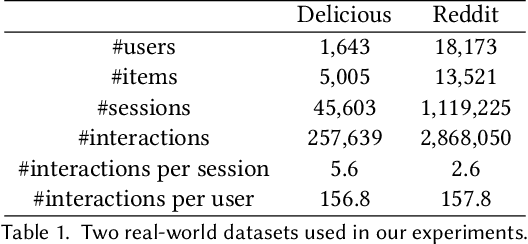
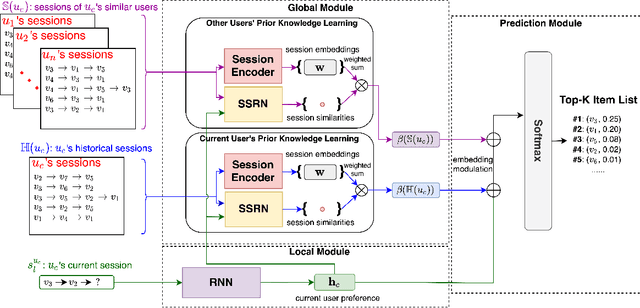
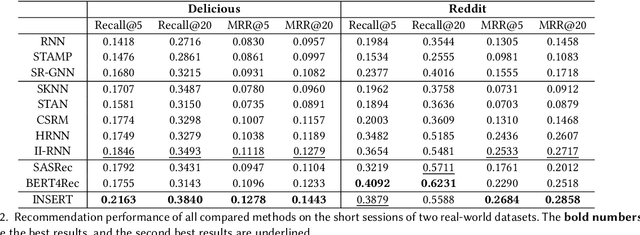
Abstract:The changing preferences of users towards items trigger the emergence of session-based recommender systems (SBRSs), which aim to model the dynamic preferences of users for next-item recommendations. However, most of the existing studies on SBRSs are based on long sessions only for recommendations, ignoring short sessions, though short sessions, in fact, account for a large proportion in most of the real-world datasets. As a result, the applicability of existing SBRSs solutions is greatly reduced. In a short session, quite limited contextual information is available, making the next-item recommendation very challenging. To this end, in this paper, inspired by the success of few-shot learning (FSL) in effectively learning a model with limited instances, we formulate the next-item recommendation as an FSL problem. Accordingly, following the basic idea of a representative approach for FSL, i.e., meta-learning, we devise an effective SBRS called INter-SEssion collaborative Recommender netTwork (INSERT) for next-item recommendations in short sessions. With the carefully devised local module and global module, INSERT is able to learn an optimal preference representation of the current user in a given short session. In particular, in the global module, a similar session retrieval network (SSRN) is designed to find out the sessions similar to the current short session from the historical sessions of both the current user and other users, respectively. The obtained similar sessions are then utilized to complement and optimize the preference representation learned from the current short session by the local module for more accurate next-item recommendations in this short session. Extensive experiments conducted on two real-world datasets demonstrate the superiority of our proposed INSERT over the state-of-the-art SBRSs when making next-item recommendations in short sessions.
A Block-based Generative Model for Attributed Networks Embedding
Jan 06, 2020

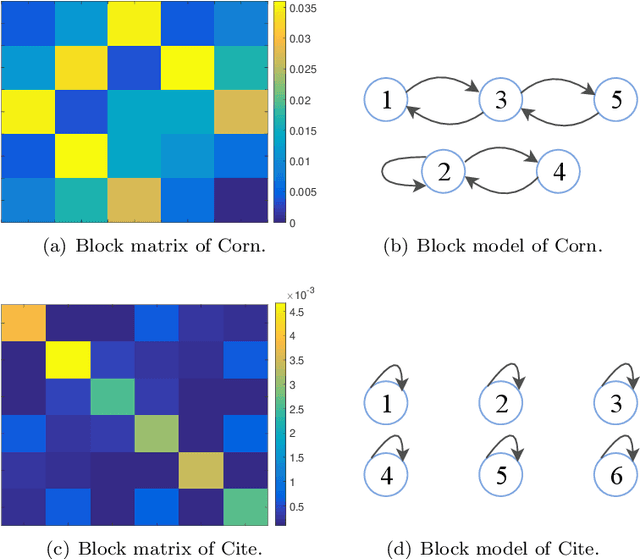
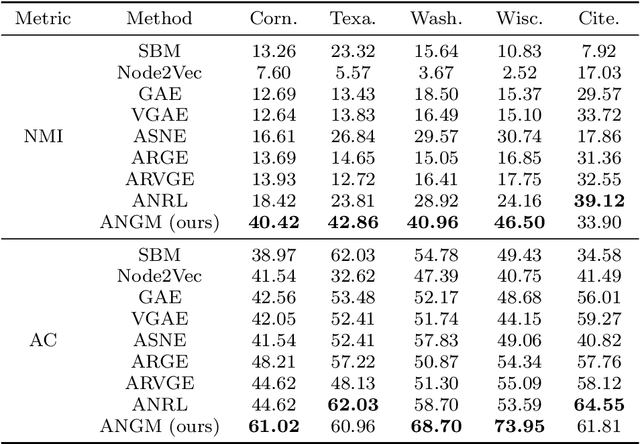
Abstract:Attributed network embedding has attracted plenty of interests in recent years. It aims to learn task-independent, low-dimension, and continuous vectors for nodes preserving both topology and attribute information. Most existing methods, such as GCN and its variations, mainly focus on the local information, i.e., the attributes of the neighbors. Thus, they have been well studied for assortative networks but ignored disassortative networks, which are common in real scenes. To address this issue, we propose a block-based generative model for attributed network embedding on a probability perspective inspired by the stochastic block model (SBM). Specifically, the nodes are assigned to several blocks wherein the nodes in the same block share the similar link patterns. These patterns can define assortative networks containing communities or disassortative networks with the multipartite, hub, or any hybrid structures. Concerning the attribute information, we assume that each node has a hidden embedding related to its assigned block, and then we use a neural network to characterize the nonlinearity between the node embedding and its attribute. We perform extensive experiments on real-world and synthetic attributed networks, and the experimental results show that our proposed method remarkably outperforms state-of-the-art embedding methods for both clustering and classification tasks, especially on disassortative networks.
Hyperbolic Node Embedding for Signed Networks
Oct 29, 2019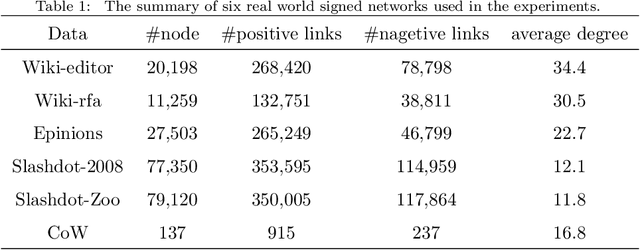
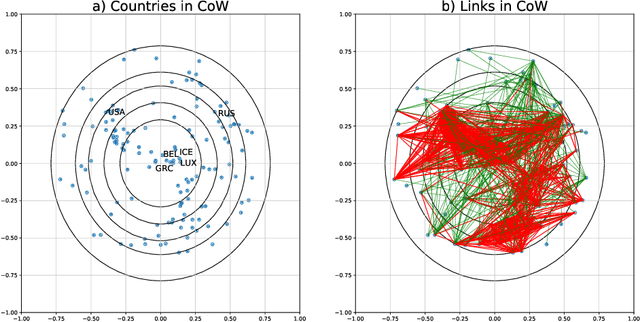
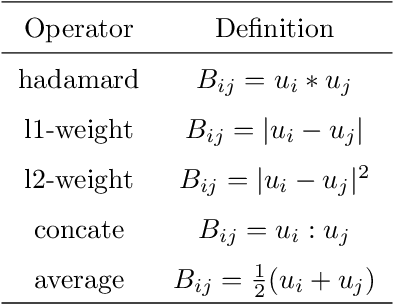
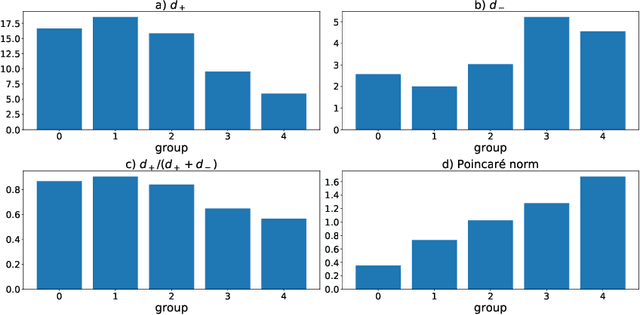
Abstract:The rapid evolving World Wide Web has produced a large amount of complex and heterogeneous network data. To facilitate network analysis algorithms, signed network embedding methods automatically learn feature vectors of nodes in signed networks. However, existing algorithms only managed to embed the networks into Euclidean spaces, although many features of signed networks reported are more suitable for non-Euclidean space. Besides, previous works also do not consider the hierarchical organization of networks, which is widely existed in real-world networks. In this work, we investigate the problem of whether the hyperbolic space is a better choice to represent signed networks. We develop a non-Euclidean signed network embedding method based on structural balance theory and Riemannian optimization. Our method embeds signed networks into a Poincar\'e ball, which is a hyperbolic space can be seen as a continuous tree. This feature enables our approach to capture underlying hierarchical structure in signed networks. We empirically compare our method with three Euclidean-based baselines in visualization, sign prediction, and reconstruction tasks on six real-world datasets. The results show that our hyperbolic embedding performs better than Euclidean counterparts and can extract a meaningful latent hierarchical structure from signed networks.
 Add to Chrome
Add to Chrome Add to Firefox
Add to Firefox Add to Edge
Add to Edge